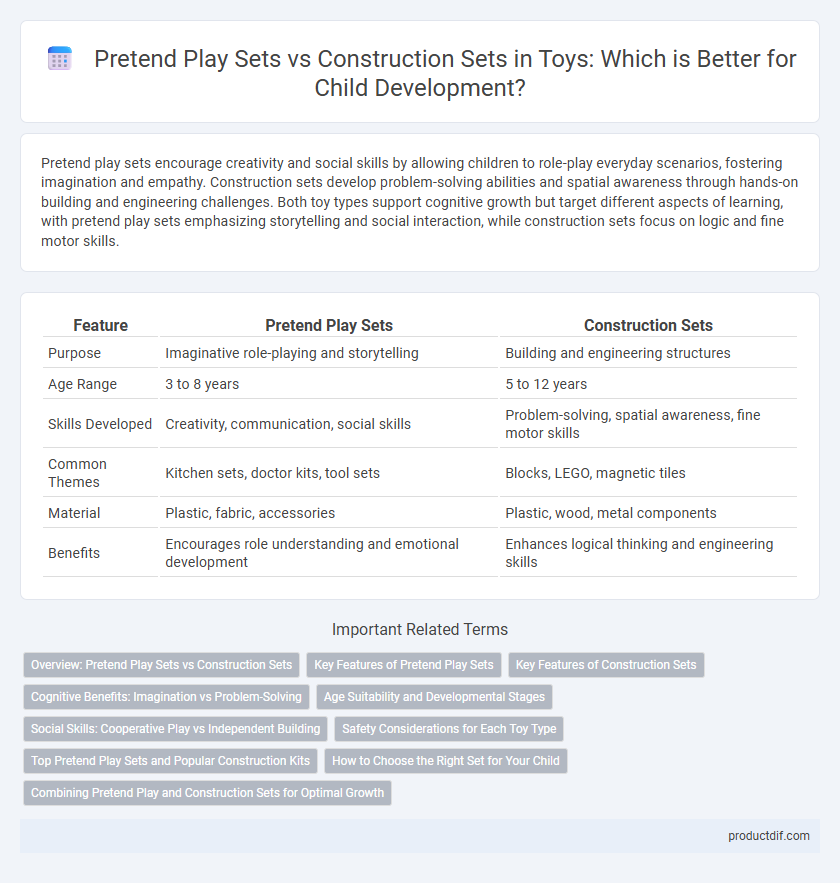Pretend play sets encourage creativity and social skills by allowing children to role-play everyday scenarios, fostering imagination and empathy. Construction sets develop problem-solving abilities and spatial awareness through hands-on building and engineering challenges. Both toy types support cognitive growth but target different aspects of learning, with pretend play sets emphasizing storytelling and social interaction, while construction sets focus on logic and fine motor skills.
Table of Comparison
| Feature | Pretend Play Sets | Construction Sets |
|---|---|---|
| Purpose | Imaginative role-playing and storytelling | Building and engineering structures |
| Age Range | 3 to 8 years | 5 to 12 years |
| Skills Developed | Creativity, communication, social skills | Problem-solving, spatial awareness, fine motor skills |
| Common Themes | Kitchen sets, doctor kits, tool sets | Blocks, LEGO, magnetic tiles |
| Material | Plastic, fabric, accessories | Plastic, wood, metal components |
| Benefits | Encourages role understanding and emotional development | Enhances logical thinking and engineering skills |
Overview: Pretend Play Sets vs Construction Sets
Pretend play sets enhance creativity and social skills by encouraging role-playing scenarios, often including items like kitchen sets, doctor kits, and costume accessories. Construction sets focus on spatial reasoning and problem-solving through building blocks, gears, and interlocking pieces, which help develop fine motor skills and STEM learning. Both toy types support cognitive development but cater to different areas: imaginative exploration versus logical assembly.
Key Features of Pretend Play Sets
Pretend play sets are designed to stimulate imagination and social skills through role-playing scenarios, featuring realistic accessories like kitchen utensils, doctor tools, or costumes. These sets emphasize narrative development and creativity, often including interactive elements such as sound effects or movable parts to enhance engagement. Unlike construction sets, pretend play toys prioritize character interaction and everyday life simulations, fostering emotional and cognitive growth in children.
Key Features of Construction Sets
Construction sets feature interlocking pieces that promote spatial reasoning and fine motor skills development in children. These sets often include gears, beams, and connectors that allow for building complex structures and functional models. Designed to foster creativity and problem-solving, construction sets provide open-ended play that encourages engineering concepts and STEM learning.
Cognitive Benefits: Imagination vs Problem-Solving
Pretend play sets enhance cognitive development by fostering creativity, narrative thinking, and social skills through role-playing scenarios. Construction sets promote problem-solving abilities, spatial reasoning, and fine motor skills by encouraging children to design, build, and experiment with structures. Both toy types support critical cognitive functions but emphasize different aspects: imagination for pretend play and logical thinking for construction.
Age Suitability and Developmental Stages
Pretend play sets are ideal for children aged 2 to 6 years, promoting social skills, creativity, and language development through role-playing scenarios. Construction sets, suitable for ages 4 to 10 years, enhance spatial awareness, problem-solving, and fine motor skills by encouraging the assembly of complex structures. Matching the toy to the child's developmental stage supports optimal cognitive growth and imaginative exploration.
Social Skills: Cooperative Play vs Independent Building
Pretend play sets encourage cooperative play by fostering communication, role-taking, and negotiation skills among children. Construction sets promote independent building, enhancing spatial reasoning and problem-solving abilities while allowing for self-directed creativity. Combining both types supports balanced social development through interactive teamwork and solitary focus.
Safety Considerations for Each Toy Type
Pretend play sets often feature small accessories and intricate parts that pose choking hazards, making them less suitable for very young children without close supervision. Construction sets typically use larger, durable components designed to minimize sharp edges, enhancing safety during assembly and play. Both toy types should comply with ASTM F963 and EN71 safety standards to ensure non-toxic materials and secure design for safe child use.
Top Pretend Play Sets and Popular Construction Kits
Top pretend play sets like kitchen sets, doctor kits, and tool benches encourage imaginative role-playing and social development in children. Popular construction kits, including LEGO sets, Magna-Tiles, and K'NEX, enhance spatial awareness, problem-solving skills, and creativity through hands-on building activities. Both toy categories offer distinct educational benefits, with pretend play fostering empathy and narrative skills, while construction sets promote engineering concepts and fine motor skills.
How to Choose the Right Set for Your Child
Choosing the right toy set for your child depends on their developmental needs and interests; pretend play sets enhance creativity and social skills by encouraging role-playing, while construction sets improve spatial reasoning and problem-solving through hands-on building activities. Assess your child's current abilities, preferences, and age appropriateness to select a set that fosters their growth effectively. Brands like LEGO and Melissa & Doug offer diverse options tailored to various skill levels, ensuring an engaging and educational experience.
Combining Pretend Play and Construction Sets for Optimal Growth
Combining pretend play sets with construction sets enhances children's cognitive and social development by encouraging creativity and problem-solving skills simultaneously. Pretend play stimulates imagination and empathy, while construction sets develop spatial awareness and fine motor skills, creating a balanced growth environment. Integrating these toy types promotes holistic learning, fostering both emotional intelligence and technical abilities.
Pretend play sets vs construction sets Infographic

 productdif.com
productdif.com